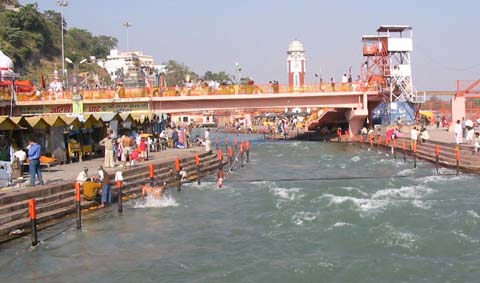| Section 6 : Ganga Action
Plan
|
||
| SECTION 1
SECTION 2 SECTION 3 SECTION 4 SECTION 5 SECTION 6 SECTION 7 SECTION 8 SECTION 9 SECTION 10 SECTION 11
|
  
Ganga Action Plan
Ganga Action Plan or GAP was a program launched by Government of India in April 1985 in order to reduce the pollution load on the river Ganga. The program was launched with much fanfare, but it terribly failed to decrease the pollution level in the river, after spending 901.71 crore (approx. 1010) rupees over a period of 15 years.
HISTORY
The Ganga Action Plan (GAP) is an ambitious plan to clean the River Ganga. It originated from the personal intervention and interest of the late Prime Minster Mrs Indira Gandhi, who requested a comprehensive survey of the situation in 1979. After five years, the Central Pollution Control Board (CPCB) published two comprehensive reports, which formed the base from which the action plan to clean up the Ganga, was developed. ■ Department of Environment, in December 1984, prepared an action plan for immediate reduction of pollution load on the river Ganga. The Cabinet approved the GAP (Ganga Action Plan) in April 1985 as a 100 per cent centrally sponsored scheme. To oversee the implementation of the GAP and to lay down policies and programmes, Government of India constituted a Central Ganga Authority (CGA) in February 1985, later renamed as the National River Conservation Authority (NRCA) in September 1995, under the chairmanship of the Prime Minister. The Government also established the Ganga Project Directorate (GDP) in June 1985 as a wing of Department of Environment, to execute the projects under the guidance and supervision of the CGA. The Government renamed the GPD as the National River Conservation Directorate (NRCD) in June 1994. ■Mr. Rajiv Gandhi, the then prime minister of India, announced the creation of CGA. GAP was launched in 5 major cities along the river. ■These five cities included Kanpur, Haridwar, Varanasi and Allahabad.
Result of Ganga action plan
Many people say that GAP was an over-ambitious project. Some other argue that money was not spent due to corruption. GAP is widely considered a failure. To know more about Ganga Action Plan, click on the below link. http://www.cag.gov.in/reports/scientific/2000_book2/gangaactionplan.htm `Ganga Action Plan bears no fruit' As per the article published in “The Hindu” newspaper. For more information click on the below link. http://www.hindu.com/2004/08/28/stories/2004082807430400.htm
NEW DELHI, AUG. 27 2004. Despite heavy investments towards cleaning the Ganga, pollution levels are just as terrifying as before. This was highlighted during the Clean Ganga Day organised by the Sankat Mochan Foundation, The Asia Foundation and the United States Agency for International Development in the Capital today. "The Ganga Action Plan was launched by the Government in Varanasi in 1986. More than 50 crores has been spent on the project but the pollution levels in the Ganga are as high as ever. Till as late as 1993, the Government said that the project had been successful. But then we started doing water testing and it was clear the sewage was till flowing into the river," said Veer Bhadra Mishra, president of the Sankat Mochan Foundation, Varanasi, at the second Clean Ganga Day. This rise in pollution despite the construction of sewage treatment plants at Varanasi, was a result of erratic power supply, faulty engineering and maintenance problems, he added. Blaming the authorities for their lackadaisical approach, Dr. Mishra also outlined the alternative solution designed by the non-governmental organisation. "We suggested an alternative solution that does not rely on power called the Advanced Integrated Water Pond System. But since 1997, the issue has been stuck and no one has been able to decide. There is fight between the Municipality and the Uttar Pradesh Jal Nigam and now the matter has reached the Court," he said. According to environmentalists, about 90 per cent of pollution into the holy river is caused by sewage generation while only about 5 to 6 per cent can be blamed on bathing and other activities. "While the real sources of pollution -- sewage -- continues to flow into the river, we are right now trying to spread awareness among citizens not to pollute the ghats. But 20 years after we started our campaign, I still feel that we have not been able to achieve anything. Our aim is still what it was -- to clean the Ganga," Dr. Mishra said.
|

